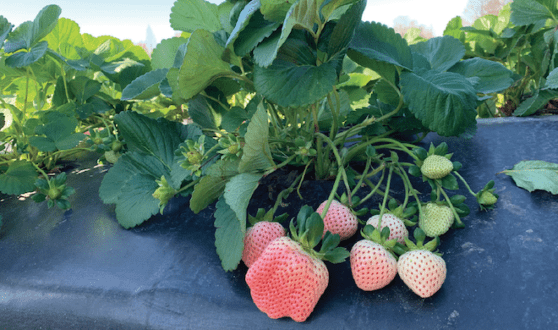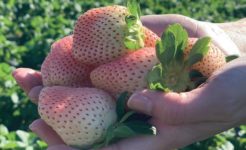

Jan 7, 2021Florida growing new ‘Fifth Berry’ white strawberry
As with Strawberry Fields Forever, Florida growers are growing a new colored strawberry to give them some ammunition to recapture customers lost to other growing regions.
Similar to the Beatles’ “Fifth Beatle,” growers are labeling white strawberries as the Fifth Berry. The white strawberry doesn’t resemble the bright red berries Florida growers are known for producing in the winter.
Growers believe white strawberries could revolutionize the category much like the four Beatles transformed rock and roll music in the 1960s. The white berry with pink seeds joins the four leading U.S. berries: strawberries, blueberries, raspberries and blackberries.
In mid-2020, the University of Florida’s (UF) Gulf Coast Research and Education Center in Wimauma, Florida, released cultivar FL 16.78-109. The Florida berry is large and firm enough to produce in large quantities and withstand shipment to distant markets while maintaining its sweet and unique taste, said breeder Vance Whitaker.
Growers say the berry provides them new weaponry which could help attract renewed retailer interest. Within the last decade, Florida strawberry growers have lost market share in Texas and the Midwest to other growing regions.
“It will help Florida differentiate itself from other districts,” said Craig Casca, executive officer and director of sales for Red Blossom, based in Los Olivos, California. “We think retail will be very receptive to promoting these once we get more volume in the future.”
The white berries, also known as pineberries, possess a pink blush when ripened and offer a sweet and unique taste. Not related to pineapples, pineberries display a hint of pineapple scent.


Growers characterize the berry as tasting “very sweet,” like a strawberry-apricot blend with a dense, unique texture. Whitaker and his breeding team expect to give it a formal name during the middle of the season.
This season, the white berries are being produced in limited quantities. About 12 acres of trials are being grown by commercial growers that will be sold in test markets to retail and foodservice channels, Whitaker said.
Wish Farms, one of Florida’s largest berry grower-shippers, is growing a “good-sized trial” this year with plots planted for several major retailers. Gary Wishnatzki, Wish Farms’ owner, said he expects considerably larger supplies to be available next year. Red Blossom expects to pack 25 to 30 cartons a day from its Florida operations.
Because of a larger Mexican presence in Texas and the Midwest, Florida strawberry growers hope the berry will help them regain sales in those regions. “This will open markets lost to us to Mexico,” Wishnatzki said. “Our market reach is going to expand because of the pineberries. This is exciting to me that for the first time in years, Florida has a chance to expand. This can do a lot more for Florida’s market presence than any trade deal.”
Wild white strawberries originated in the 1700s and 1800s in Chile. Since 2010, Europe has been commercially growing a similar niche variety known for its flavor and appearance. The berries sell for high prices at gourmet European retailers and eateries.
FL 16.78-109 is in the same species as the European and Japanese varieties. The Florida berry’s agronomic and flavor characteristics differ from the European fruit. Besides the color, the Florida fruit is closer to a normal Florida strawberry. According to Whitaker, the European pineberries are similar to the wild characteristics, with small and soft but aromatic fruit. Wishnatzki said the Florida fruit is slightly softer than red strawberries.
The white fruit is a little smaller than the red varieties, with yield about 25% lower, Whitaker said. The berry’s growing practices, including planting dates and fertilization, should be similar to red strawberries. Whitaker said the harvesting and quality control process, however, will be more challenging.
White berries require some time to learn how to pick at just the right stage of ripeness. The white color displays blemishes a little more than the red berries. “So quality control will be a bit trickier than for red berries, and growers will need to get a good return for the product in order for it to be profitable,” Whitaker said.
UF’s breeding concentrates on berry marketability. “The main focus in developing this has been on taste and quality, and secondarily on yield,” Whitaker said. “Otherwise, the variety is well-adapted to growing in Florida conditions.”
“Florida companies have the first access to this variety,” Whitaker said. “My hope is that it will benefit the Florida strawberry industry as a whole, assuming it could become a high-value market segment that complements red berries.”
Volume isn’t large enough for retailers to feature the berries in store ads. Still, the berry is attracting shopper interest, Wishnatzki said.
Florida growers start harvesting in November. Volume typically builds in December with promotable volume beginning around Christmas. The deal usually ends in April, when California strawberries begin harvesting.
— Doug Ohlemeier, VGN correspondent














